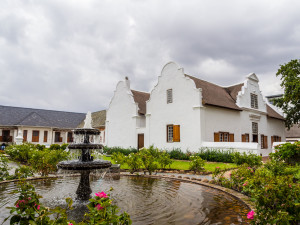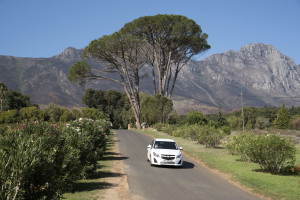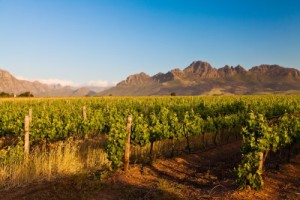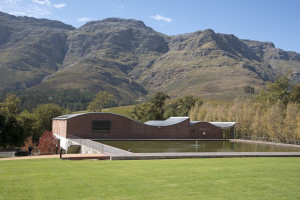Today we have a conference preview from Jim Clarke who tells us the story behind his session “Stellenbosch: Seven Wards, or More?” Read on to hear the story of Stellenbosch!
In my position with Wines Of South Africa I go to South Africa a couple times each year. Many wine industry folks assume I spend my time in Cape Town. It’s a wonderful city, and I’m always glad to do so, but I actually spend the bulk of my time in Stellenbosch; Cape Town may be the capital of the Western Cape, but Stellenbosch is the capital of the wine region. It’s home to 171 of the Rainbow Nation’s 566 producers, and has more vines and more vineyard land than any other district. Most of the country’s winemakers and viticulturalists study there, either at Stellenbosch University or at Elsenburg Agricultural College. It’s no accident that the WOSA’s offices are located there.
Stellenbosch is small, a town rather than a city by most standards; it swells from 155,000 people to 184,000 when the University is in session, and for the visitor the town’s center is concentrated in just a few blocks. But the city is almost as old as Cape Town; Jan Van Riebeeck founded the latter in 1652, and his successor as Commander, and eventually first Governor of the Cape Colony, Simon Van Der Stel, founded Stellenbosch just 27 years later.
Not a modest man, Van Der Stel named the city after himself – Stellenbosch means “Stel’s wood” or “Stel’s forest” – and his name adorns two of the three mountains that define the district’s shape, Simonsberg and Stellenbosch Mountain (the third being Helderberg, “Clear Mountain”). Incidentally, among Van Der Stel’s other contributions to the South African wine industry was the planting of 10,000 vines at his estate in Constantia in 1685, which became the home for the famous, eponymous wine later in the 18th and into the 19th centuries.
Stellenbosch gained even more trees and a nickname, the City of Oaks, thanks to Stel’s policy of planting oaks along the streets of town. (How many trees? They’re so common that there’s a saying about what makes a “true” “Maty,” as the University students are called: they’ve kissed someone by the Eerste River, which runs through town; they’ve failed a class; and…they’ve been hit on the head by an acorn). Planting of vines, which would quickly become more important, happened at the same time.
Stellenbosch has many estates that date back to the 17th century: Rustenberg dates to1682; Welmoed, today home to Stellenbosch Vineyards, to 1690, and Lanzerac to 1692. Many still display the typical Cape Dutch architecture of the period: imagine the front of a whitewashed Amsterdam townhouse, with its rounded gables, if it was no longer hemmed in by neighbors, allowing it to expand on both sides, all topped with a thatched roof.
These and other early wine estates sprouted along on the alluvial fans of the mountains I mentioned earlier. The slopes provide good exposures and the soils, decomposed granite shed from the mountains over millennia, aren’t very fertile, making them perfect for winegrowing. Stellenbosch’s wine estates extend from the Simonsberg’s south-facing slopes, 25 km from False Bay, to the far side of the Helderberg, where Vergelegen, another classic founded in 1700, lies just 8 km from the water. Plantings began in the Bottelary Hills, on the far side of the town center from Stellenbosch Mountain, in the 18th century.
Even some of the valleys like Banghoek (the pass to Paarl and Franschhoek) and Jonkershoek saw vines planted early on as well, but many of these were planted over or neglected when the South African wine industry faltered, first due to phylloxera at the end of the 19th century and then from a depression brought on by World War I. With the end of apartheid, renewed contact with the outside world both expanded the market for South African wines and brought a new perspective to viticultural practices. This inspired innovators like Neil Ellis to explore and replant these valleys and bring them back into prominence.
There are few Stellenbosch locations suitable to viticulture that aren’t planted with vines these days. Perhaps the last spot to be filled in were the orchards that Madame May de Lencquesaing, former owner of the Second Growth Chateau Pichon Comtesse de Lalande purchased and began planting in 2003 to create Glenelly.
Stellenbosch’s long, rich history means its producers have been exploring the terroir for centuries; they’ve discovered a tapestry of growing conditions that make Stellenbosch capable of great wines of all sorts – sparkling Methode Cap Classiques, fresh Sauvignon Blancs and Chenin Blancs, and even Riesling on the white wine side, and complex Bordeaux and Rhone varieties (and yes, even Pinot Noir) among the reds.
The Simonsberg-Stellenbosch ward has become one of the premier homes of Pinotage – fittingly, as the variety was developed nearby at the University in the 1920s. Given how diverse South Africa’s Winelands are in their total, it’s only appropriate that the most important region there show similar range – South Africa in microcosm. And what does one do when one comes to Africa? Explore.
Jim Clarke’s session, entitled “Stellenbosch: Seven Wards, or More?” will be held on Thursday, August 11th at 1:30 PM as part of SWE’s 40th Annual Conference. Here’s how Jim describes this tasting session: The home of South Africa’s wine industry, Stellenbosch is the most explored terroir in South Africa, sub-divided into seven wards with some areas, such as the Helderberg, yet to have an official ward designation. Simonsberg-Stellenbosch seems particularly suited to Pinotage, while the Blauwklippen Valley leans toward powerful Syrahs, and the Banghoek Valley has made a name for its Chardonnays. Wines of South Africa’s Marketing Manager Jim Clarke will explore Stellenbosch’s terroirs, highlighting the strengths of each and explaining why these ward names don’t appear on labels as much as they should.



